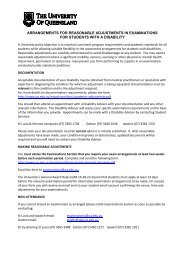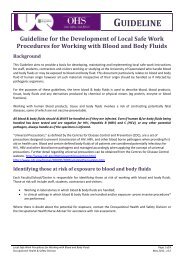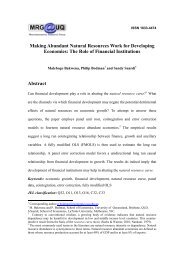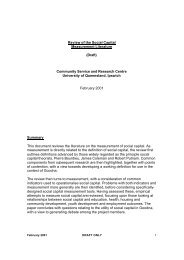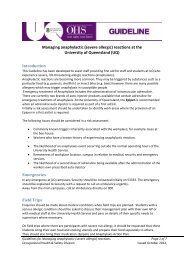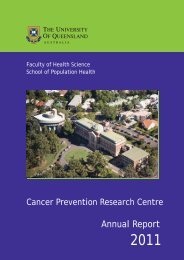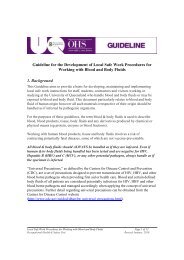Recognising and Responding to Domestic and Family Violence
Recognising and Responding to Domestic and Family Violence
Recognising and Responding to Domestic and Family Violence
Create successful ePaper yourself
Turn your PDF publications into a flip-book with our unique Google optimized e-Paper software.
<strong>Recognising</strong> <strong>and</strong> <strong>Responding</strong> <strong>to</strong><br />
<strong>Domestic</strong> <strong>and</strong> <strong>Family</strong> <strong>Violence</strong><br />
Presented by Ipswich Women’s s Centre Against <strong>Domestic</strong><br />
<strong>Violence</strong>
Introduction<br />
Presenters<br />
‣ Vanessa Coady – <strong>Domestic</strong> & <strong>Family</strong> <strong>Violence</strong><br />
Support Worker (May 2001 – Present)<br />
‣ Rebecca Shearman – Child & Young People’s<br />
Worker (August 2003 – September 2006)<br />
Ipswich Women’s Centre Against <strong>Domestic</strong> <strong>Violence</strong>
Introduction Continued<br />
This presentation will:<br />
‣ Focus on the impacts of domestic <strong>and</strong> family violence on women <strong>and</strong><br />
children as this is the presenters’ area of expertise (however, a lot of these<br />
skills are transferable <strong>to</strong> survivors of different types of trauma);<br />
‣ Assume a certain level of knowledge about domestic <strong>and</strong> family violence,<br />
including the types <strong>and</strong> range of abuse (this is due <strong>to</strong> time constraints);<br />
‣ Provide extra information about domestic <strong>and</strong> family violence in the form<br />
of booklets that you can take with you;<br />
‣ Present some statistics <strong>and</strong> with the audience highlight some of the<br />
impacts of domestic <strong>and</strong> family violence on women, children <strong>and</strong> young<br />
people;<br />
‣ Using case studies <strong>and</strong> role plays, identify best practice in relation <strong>to</strong><br />
recognising, raising <strong>and</strong> responding <strong>to</strong> women <strong>and</strong> children experiencing<br />
domestic <strong>and</strong> family violence
Facts about <strong>Domestic</strong>/<strong>Family</strong><br />
<strong>Violence</strong><br />
‣ According <strong>to</strong> the Australian Bureau of Statistics:<br />
“23% of Australian women who have ever been married or in a defac<strong>to</strong><br />
relationship experienced violence by a partner at some time during the<br />
relationship”<br />
(ABS 1996)<br />
‣ <strong>Domestic</strong> violence can result in severe physical injury (which can cause<br />
permanent disability); <strong>and</strong> its ultimate result can be murder<br />
‣<strong>Domestic</strong> violence is the leading cause of injury <strong>to</strong> women, more than<br />
au<strong>to</strong> accidents, rapes <strong>and</strong> muggings combined. Women’s independence in<br />
making the decision <strong>to</strong> leave may be compromised by her partner’s need <strong>to</strong><br />
dominate her <strong>and</strong> control many aspects of her life
Facts about <strong>Domestic</strong>/<strong>Family</strong><br />
<strong>Violence</strong>- Cont’d<br />
‣ Of all the murder-suicides in Australia from July 1989 – June 1996, 43%<br />
were committed by partners or former partners of the victims. Of these,<br />
73.6% of victims were women <strong>and</strong> 91.4% of the offenders were men”<br />
(Australian Institute of Criminology March 1998)<br />
‣ We regularly hear on the news of “domestic disputes” where people are killed.<br />
We do not hear how these people were victims of ongoing domestic violence,<br />
which culminated in their murder. Instead, the issue is masked as being an<br />
argument gone wrong, a once off dispute. <strong>Domestic</strong> violence is rarely a once-off<br />
incident. It is an ongoing cycle of abuse
The Effects of <strong>Domestic</strong> & <strong>Family</strong><br />
<strong>Violence</strong> on Women <strong>and</strong> Children –<br />
Brains<strong>to</strong>rming Exercise<br />
‣ In your experience, what are some of the effects of<br />
experiencing domestic or family violence on adult<br />
women?<br />
‣ What have you noticed are the impacts of witnessing<br />
or experiencing domestic or family violence on children<br />
or young people?
Effects on Women<br />
‣ Isolation<br />
‣ Poor self-esteem<br />
‣ Poor self-confidence<br />
‣ Loss of freedom <strong>and</strong> rights<br />
‣ Feelings of hopelessness <strong>and</strong> helplessness<br />
‣ Difficulty making their own decisions<br />
‣ Minimising or denying the abuse<br />
‣ Silence<br />
‣ Attempting <strong>to</strong> please others
Effects on Women- Cont’d<br />
‣ Feeling ashamed<br />
‣ Sadness <strong>and</strong> frequent crying<br />
‣ Confusion<br />
‣ Stress-related illness<br />
‣ Exhaustion<br />
‣ Eating issues<br />
‣ Abuse of alcohol or drugs<br />
‣ Depression<br />
‣ Anxiety, fear <strong>and</strong> panic
Effects on Women- Cont’d<br />
‣ Anger<br />
‣ Feeling paranoid <strong>and</strong> crazy<br />
‣ Feelings of guilt<br />
‣ Feeling as though they are responsible for the abuse<br />
‣ Feeling like they have failed<br />
‣ Many women that we see at our Service are not only coping with the present<br />
violence <strong>and</strong> abuse but also the effects of the domestic violence they may have<br />
experienced as a child. The impact of domestic violence can also be significantly<br />
greater for women from non-English speaking backgrounds, Indigenous women<br />
<strong>and</strong> rural women. Women survivors of domestic violence are also experiencing the<br />
effects of mainstream society that tends <strong>to</strong> blame <strong>and</strong> isolate women in domestic<br />
violence situations
Effects on Children/Young<br />
People<br />
Infants<br />
‣ Poor health <strong>and</strong> sleeping habits<br />
‣ Excessive Screaming<br />
‣ Attachment <strong>to</strong> mother may be disrupted leading <strong>to</strong> emotional deprivation<br />
‣ Permanently altered development of the infant’s central nervous system<br />
resulting in ongoing levels of anxiety, hyperactivity <strong>and</strong> mood disorders[1]<br />
Infants show clear disturbances in response <strong>to</strong> domestic violence from at least six<br />
weeks of age[2]<br />
[1] Critical Directions (2001), Vol 1 No 1<br />
[2] Zeanah (1998) in The Way Forward: Children, Young People <strong>and</strong> <strong>Domestic</strong><br />
<strong>Violence</strong> (2000)
Effects on Children/Young<br />
People- Cont’d<br />
Toddlers<br />
‣ Frequent illness<br />
‣ Low self-esteem <strong>and</strong> shyness<br />
‣ Fear<br />
‣ Social problems such as hitting or biting<br />
‣ Withdrawn, passive, clinging, anxious (most often girls)<br />
‣ Aggressive behaviour (most often boys)<br />
Pre-Schoolers<br />
In addition <strong>to</strong> the above characteristics:<br />
‣ Somatic complaints<br />
‣ Blaming themselves for the violence <strong>and</strong> feeling guilty
Effects on Children/Young<br />
People- Cont’d<br />
Primary School Aged Children<br />
In addition <strong>to</strong> the above characteristics:<br />
‣ Difficulties with school work <strong>and</strong> school attendance<br />
‣ Difficulty concentrating<br />
‣ Poor social skills <strong>and</strong> fighting with peers<br />
‣ Rebelling against adult authority<br />
‣ Aggression <strong>and</strong> poor anger management (most often boys)<br />
‣ Anxiety <strong>and</strong> withdrawal (most often girls)<br />
‣ Depression<br />
‣ Low self esteem <strong>and</strong> lack of confidence<br />
‣ Post Traumatic Stress Disorder
Effects on Children/Young People<br />
Cont’d<br />
Adolescents/Young People<br />
In addition <strong>to</strong> the above characteristics:<br />
‣ Depression<br />
‣ Aggression<br />
‣ Violent “delinquency”<br />
‣ Adolescent boys (more than adolescent girls) may model the<br />
perpetra<strong>to</strong>r’s s behaviour by assaulting their mother or siblings
Case Scenario<br />
‣ Sarah, a 28 year old woman, presents at your workplace with her 2 children – her 10<br />
year old son Jake <strong>and</strong> her 7 year old daughter Emily<br />
‣ You find a quiet place <strong>to</strong> sit <strong>and</strong> talk but Sarah’s two kids refuse <strong>to</strong> leave her side <strong>to</strong> go<br />
<strong>and</strong> play. It is a very hot day, but Sarah is wearing an oversized jumper <strong>and</strong> long baggy<br />
pants. She has a scarf around her head . You notice that she is very thin <strong>and</strong> her fingers<br />
are inflamed around her nails<br />
‣ When you begin talking with her, she sits hunched over with her arms crossed <strong>and</strong><br />
constantly bites her fingernails. The 2 children are dressed in very good clothes <strong>and</strong> Sarah<br />
seems overly concerned with keeping them clean<br />
‣ Emily insists on sitting on her mum’s lap <strong>and</strong> studies you intently but will not make eye<br />
contact with you or answer you when you offer her some food. Jake begins running around<br />
the room pulling things off shelves <strong>and</strong> constantly interrupting. When Sarah asks him <strong>to</strong><br />
play quietly, he says “Shut up you idiot! Dad said I don’t have <strong>to</strong> listen <strong>to</strong> you!”<br />
‣ Jake tells you he wants <strong>to</strong> take home the calcula<strong>to</strong>r he sees on your desk. When you<br />
explain that he can’t have it, he begins pleading with you <strong>and</strong> eventually throws a tantrum.
Case Scenario – Cont’d<br />
‣ When you manage <strong>to</strong> talk <strong>to</strong> Sarah, she says she needs some money<br />
because she’s stupid <strong>and</strong> doesn’t know how <strong>to</strong> manage the budget that her<br />
husb<strong>and</strong> gives her. When asked about her husb<strong>and</strong>, Sarah describes him as an<br />
extremely intelligent man, saying she doesn’t know why he puts up with her<br />
‣ Despite the fact that Sarah has come asking for money, you suspect there<br />
may be some violence going on in the home. What gives you these suspicions?<br />
‣ Discuss your responses in groups of 4-6. There will be approximately 15<br />
minutes of discussion
<strong>Recognising</strong> <strong>Domestic</strong> <strong>Violence</strong><br />
A Woman victim/survivor of domestic violence may display one or more of the<br />
following characteristics:<br />
‣ She may have frequent physical injuries – bruises, broken bones, wrist or ankle<br />
sprains, cuts<br />
‣ She may have inconsistent or implausible explanations for her injuries<br />
‣ She may appear quiet, afraid <strong>to</strong> speak, anxious, depressed, withdrawn,<br />
continually devalue herself. She may have no self-confidence<br />
‣ She may appear <strong>to</strong> be under the control of her partner<br />
‣ She may be socially isolated, reluctant/unable <strong>to</strong> participate in community<br />
activities/events, unable <strong>to</strong> go <strong>to</strong> work or <strong>to</strong> study <strong>and</strong> she may always be seeking<br />
her partner’s permission before committing <strong>to</strong> activities<br />
‣ She may appear fearful
<strong>Recognising</strong> DV- Cont’d<br />
‣ She may usually wear very concealing clothing in order <strong>to</strong> hide bruising <strong>and</strong><br />
injuries<br />
‣ She may be unable <strong>to</strong> talk on the phone for any length of time <strong>and</strong> makes<br />
excuses <strong>to</strong> finish the conversation quickly<br />
‣ She may s<strong>to</strong>p seeing family <strong>and</strong> friends <strong>and</strong> makes excuses for not attending<br />
family gatherings<br />
‣ She may often be without money<br />
‣ She may look stressed <strong>and</strong> worn out<br />
‣ She may become defensive if people express concern about her well-being<br />
‣ Her partner may ridicule her or put her down in front of others<br />
Source of information: Queensl<strong>and</strong> <strong>Domestic</strong> <strong>Violence</strong> Services network, 2002, “ Reaching<br />
Out-a domestic violence information session for family <strong>and</strong> friends”
<strong>Recognising</strong> DV- Cont’d<br />
A child who has experienced domestic violence may:<br />
‣ Appear tired <strong>and</strong> stressed<br />
‣ Be distracted <strong>and</strong> unable <strong>to</strong> concentrate at school<br />
‣ Be withdrawn <strong>and</strong> isolated, emotionally detached <strong>and</strong> unavailable<br />
‣ Be hyper-vigilant <strong>and</strong> watchful<br />
‣ Experience physical symp<strong>to</strong>ms such as s<strong>to</strong>mach ache, head ache<br />
‣ Be restless, emotionally distraught <strong>and</strong> have difficulty managing stress or<br />
tension<br />
‣ Be abusive <strong>and</strong> aggressive (eg with siblings, peers or parents)<br />
Source of information: Queensl<strong>and</strong> <strong>Domestic</strong> <strong>Violence</strong> Services Network 2002, “Reaching<br />
Out- a domestic violence information session for family <strong>and</strong> friends”.
Raising the Issue of <strong>Violence</strong><br />
‣ There is often anxiety amongst workers regarding how <strong>to</strong> raise the issue of<br />
domestic violence if they suspect that this is what is occurring. In addition, there is<br />
the compounding fac<strong>to</strong>r of clients who do not disclose violence because the<br />
workers do not ask them<br />
‣ Listed below are a series of questions, which may help workers <strong>to</strong> provide their<br />
clients with the opportunity <strong>to</strong> disclose the violence:<br />
• Does your partner ever make you do things which make you feel<br />
uncomfortable, or which hurt you?<br />
• Has your partner ever forced you <strong>to</strong> have sex when you didn’t want <strong>to</strong>?<br />
• Has anyone ever forced you <strong>to</strong> do sexual things when you didn’t want <strong>to</strong>?<br />
• Are you afraid for your safety or that of your children?<br />
• You mentioned that your partner uses drugs/alcohol. How does he act<br />
when he is drinking/on drugs?
Raising the Issue of <strong>Violence</strong>-<br />
Cont’d<br />
• Are you (have you ever been) in a relationship in which you feel you are being<br />
treated badly? In what ways?<br />
• We all have disagreements sometimes. What happens when you <strong>and</strong> your<br />
partner fight or disagree?<br />
• I noticed you have a number of bruises. Could you tell me how they happened?<br />
Did someone hit you?<br />
• Are you ever frightened of your partner?<br />
• Many clients tell me they have been hurt by someone close <strong>to</strong> them. Could this<br />
be happening <strong>to</strong> you?<br />
• Your partner seems very concerned <strong>and</strong> anxious. Was he responsible for your<br />
injuries?<br />
• You seem frightened of your partner. Has he ever hurt you?<br />
• Sometimes when others are over-protective <strong>and</strong> as jealous as you describe, they<br />
react strongly <strong>and</strong> use physical force. Is this happening in your situation?
Raising the Issue of <strong>Violence</strong>-<br />
Cont’d<br />
• Have you ever been in a relationship where you have been hit, punched, kicked<br />
or hurt in any way? Are you in such a relationship now?<br />
• You mentioned your spouse loses his temper with the children. Does he lose his<br />
temper with you?<br />
• Does he become abusive when he loses his temper?<br />
• What happens when you <strong>and</strong> your partner argue?<br />
• Does your partner ever call you names or put you down?<br />
• Does your partner destroy things you care about?<br />
• Has your partner ever threatened <strong>to</strong> hurt you when you disagree with him?<br />
• Have you ever been forced <strong>to</strong> engage in sex that made you feel uncomfortable?
Raising the Issue of <strong>Violence</strong>-<br />
Cont’d<br />
• Who controls the finances in your house?<br />
• Who makes the rules? What happens when you don’t follow the rules?<br />
• Because abuse <strong>and</strong> violence are so common, I ask many female clients about<br />
it routinely<br />
• Does your partner watch your every move? Accuse you of having affairs?<br />
• What’s your social life like? Do you have any friends here?<br />
(Taken from Office of Women’s Policy, Kelly, P. 1996, <strong>Domestic</strong> <strong>Violence</strong> Helpful<br />
Comments & Questions, 7th International Congress on Women’s Health Issues)
Raising the Issue of <strong>Violence</strong> with<br />
Children & Young People<br />
‣ Many of the skills for raising violence with women also apply with children,<br />
in that it is more beneficial <strong>to</strong> be clear <strong>and</strong> direct, whilst remaining sensitive<br />
<strong>and</strong> ensuring that the child is not coerced in<strong>to</strong> saying more than they are<br />
prepared <strong>to</strong><br />
‣ Generally children who have witnessed or experience violence in the home<br />
find it difficult <strong>to</strong> trust other adults, so you may need <strong>to</strong> spend d some time<br />
building trust before you can expect a child or young person <strong>to</strong> disclose<br />
violence or abuse<br />
‣ That said, it is important <strong>to</strong> honour a child’s s trust when they tell you about<br />
abuse by responding appropriately (we will talk more about this in the next<br />
section)
Raising the Issue with Children &<br />
Young People – Cont’d<br />
Some suggestions for questions or openers that you might use are e below:<br />
‣ How are things going at home for you?<br />
‣ Sometimes adults can hurt each other when they fight – does this happen in<br />
your home?<br />
‣ I have noticed that you often have bruises <strong>and</strong> marks on your body. How did<br />
you get these?<br />
‣ Sometimes children live in families where there is violence, <strong>and</strong> people get<br />
hurt. Has this ever happened <strong>to</strong> you?<br />
‣ Are you scared of anyone at home?<br />
‣ I have noticed that you often look scared/sad/angry/anxious. Is there anything<br />
that you would like <strong>to</strong> talk about with me?<br />
‣ Often children misbehave because something is going wrong at home. Can you<br />
tell me more about what is happening in your home?<br />
‣ I just wanted <strong>to</strong> let you know that if anything upsetting was happening pening for you<br />
that you can talk <strong>to</strong> me about it.
<strong>Responding</strong> <strong>to</strong> a Disclosure<br />
Be aware of who SHE is:<br />
‣ Allow her <strong>to</strong> tell her s<strong>to</strong>ry. Let her know that you believe her <strong>and</strong> want <strong>to</strong> hear<br />
about her experiences. Be non-judgemental<br />
‣ Help her identify her feelings. Support her right <strong>to</strong> be angry. Don’t deny any of<br />
her feelings<br />
‣ Communicate <strong>to</strong> her that she is not responsible for the violence<br />
‣ Be sensitive <strong>to</strong> the differences, realise that no woman is a stereotype <strong>and</strong><br />
each has different life experiences<br />
‣ Respect the cultural values <strong>and</strong> beliefs that affect her behaviour. Know that<br />
these beliefs may have been a source of security for her in the past <strong>and</strong> their<br />
importance <strong>to</strong> her should not be minimised<br />
‣ Be aware of the differences between rural <strong>and</strong> urban women. Be aware of the<br />
physical isolation <strong>and</strong> cultural values of rural women
<strong>Responding</strong> <strong>to</strong> a Disclosure-<br />
Cont’d<br />
‣ Know that she does not need rescuing. Help her <strong>to</strong> identify her own needs<br />
‣ Explore <strong>and</strong> dispel myths<br />
‣ Provide accurate information<br />
‣ Ensure that she has the opportunity <strong>to</strong> make decisions about events which affect<br />
her life<br />
‣ Accept differences of opinion while remaining supportive<br />
‣ Provide appropriate referral<br />
‣ Remember, a victim of domestic violence is in crisis that prevents her<br />
from using her coping skills <strong>and</strong> problem solving abilities. Help her get in<br />
<strong>to</strong>uch with her strengths <strong>and</strong> emotional resources, <strong>and</strong> the decision she<br />
makes will be her own
<strong>Responding</strong> <strong>to</strong> a Disclosure-<br />
Cont’d<br />
Be aware of who YOU are:<br />
‣ Be aware of your own attitudes, experiences, <strong>and</strong> reactions <strong>to</strong> violence<br />
‣ Know your own limits of time <strong>and</strong> energy. Be aware of your agency’s<br />
policies <strong>and</strong> services so you can be realistic<br />
‣ Be aware of own need <strong>to</strong> be a powerful expert. Do not give advice. A victim<br />
of domestic violence has had countless people tell her what <strong>to</strong> do. She needs<br />
someone <strong>to</strong> care<br />
‣ Be conscious of your own cultural biases, beliefs, <strong>and</strong> prejudices when<br />
supporting women from different ethnic backgrounds<br />
‣ Do not diagnose. Focus on concrete problem solving <strong>and</strong> emotional support,<br />
not subjective interpretations of behaviour<br />
‣ Do not convey disappointment if the woman elects <strong>to</strong> return <strong>to</strong> the violent<br />
relationship. Be honest <strong>and</strong> explain your fear, but let her know she can always<br />
come back <strong>and</strong> that you still care about her
<strong>Responding</strong> <strong>to</strong> a Disclosure-<br />
Cont’d<br />
‣ Remember, you may be one of the first people in her life <strong>to</strong> show respect <strong>and</strong><br />
support at a time when she needs it most. What you get in return is the knowledge<br />
that you have been helpful <strong>to</strong> someone.<br />
Source of information: Brain Nelson (2002) DV Resources from Academic <strong>Family</strong> Medicine<br />
Mail-list Archive-Counselling Battered Women, USA
<strong>Responding</strong> & Intervention with<br />
Children & Young People<br />
‣ All of the points raised in the previous section in relation <strong>to</strong> responding <strong>to</strong><br />
women generally apply <strong>to</strong> children <strong>and</strong> young people. However, it is<br />
important <strong>to</strong> raise a number of additional points:<br />
‣ One of the most therapeutically beneficial interventions is the quality of the<br />
relationship between the therapist <strong>and</strong> the child, where the counsellor<br />
establishes good rapport, builds trust, <strong>and</strong> models appropriate interactions<br />
i<br />
between adults <strong>and</strong> children;<br />
‣ As children often struggle <strong>to</strong> articulate their feelings <strong>and</strong> thoughts,<br />
interventions with children are less reliant on the “talk therapies”, , <strong>and</strong><br />
usually need <strong>to</strong> focus more on play therapies or symbol work. For example,<br />
in my work I utilise games, s<strong>and</strong>-tray, worksheets, art & craft, symbol<br />
exercises, strength cards <strong>and</strong> directed play. Also, my practice framework f<br />
is<br />
influenced by feminist, narrative, strength-based, expressive techniques <strong>and</strong><br />
Jungian perspectives
The ABDCE Model of<br />
Intervention<br />
A - Ask <strong>to</strong> be alone: This is <strong>to</strong> ensure that the survivor is able <strong>to</strong> disclose if they<br />
choose <strong>to</strong> do so. A disclosure is highly unlikely if the worker attend <strong>to</strong> the survivor<br />
with their partner present<br />
B - Believe the disclosure: No matter how unbelievable or bizarre the s<strong>to</strong>ry,<br />
believe it, as survivors rarely lie about the violence they have survived, if anything<br />
they minimise it<br />
C - Call in resources: Be aware of agencies that can assist the survivor for<br />
example- women’s refuges, domestic violence counsellors, sexual assault referral<br />
centres<br />
D - Document his<strong>to</strong>ry <strong>and</strong> injuries: This is vitally important as this<br />
documentation may be used in court <strong>to</strong> support a survivor’s case<br />
E - Ensure safety: The safety of the survivor <strong>and</strong> any children involved is<br />
paramount. The worker should ask the woman if she fears for her safety or for the<br />
safety of her children. The worker should always be aware that the severity of
The ABCDE Model of<br />
Intervention- Cont’d<br />
previous violence is no indica<strong>to</strong>r of future violence, <strong>and</strong> that many survivors<br />
minimise the violence. Research has clearly shown that violence generally<br />
escalates both in frequency <strong>and</strong> severity. Never treat any threat that a DV offender<br />
makes as idle<br />
Source of Information: Health department of Western Australia, “<strong>Family</strong> <strong>and</strong> <strong>Domestic</strong><br />
<strong>Violence</strong> Training Package-Participants Kit, Australia
Referral & Safety Planning<br />
‣ Developing a safety plan for women escaping domestic violence is very<br />
important, as it will allow her <strong>to</strong> leave safely, feeling organised <strong>and</strong> in control of her<br />
circumstances. Some women may develop their safety plan over a period of time,<br />
however, it is more common that a woman will leave in a time of crisis <strong>and</strong> only<br />
part of this plan will be developed <strong>and</strong> put in<strong>to</strong> action<br />
‣ In assisting a woman <strong>to</strong> develop a safety plan consider the following:<br />
• If possible, deposit money in<strong>to</strong> a bank account each week, or take small<br />
items out of the house in preparation for leaving<br />
• Hide a bag in a safe place, for example a neighbour’s place, under the bed,<br />
on <strong>to</strong>p of the cupboard or in any safe place. In a bag have things such as:<br />
Spare clothes<br />
Cash<br />
Birth certificates (hers <strong>and</strong> the children’s)<br />
Marriage certificate<br />
Travel documents (hers <strong>and</strong> the children’s)
Referral & Safety Planning-<br />
Cont’d<br />
Residency documents<br />
Drivers licence<br />
Bank cards <strong>and</strong> account details<br />
Medication (hers <strong>and</strong> children’s)<br />
Centrelink documents<br />
Copies of any domestic violence orders<br />
Insurance policies<br />
Copies of any deeds <strong>to</strong> the property<br />
House keys<br />
Tax file number<br />
Awards from school/university/TAFE
Referral & Safety Planning-<br />
Cont’d<br />
Jewellery <strong>and</strong> valuables<br />
Personal items-<strong>to</strong>othbrushes, cosmetics etc<br />
Sentimental items/special pho<strong>to</strong>s-especially of/for the children<br />
Address book<br />
Any other important documents<br />
‣ Advise her <strong>to</strong> keep with her at all times important phone numbers, such as family,<br />
friends <strong>and</strong> emergency services such as a <strong>Domestic</strong> <strong>Violence</strong> Crisis Phone Number,<br />
Lifeline or Salvation Army<br />
‣ Talk <strong>to</strong> her about when would be a safe time <strong>to</strong> leave <strong>and</strong> help her <strong>to</strong> plan where she<br />
would go. When he is out on business or at work? Attending doc<strong>to</strong>rs or other<br />
appointment? Shelter accommodation is an option for women <strong>and</strong> their children who<br />
feel they are in immediate danger. Women need <strong>to</strong> contact DV Connect on 1800 811<br />
811 for shelter placement<br />
‣ Inform her about Protection Orders, assist with Centrelink payment
Referral & Safety Planning-<br />
Cont’d<br />
‣ Does he have firearms? Consider hiding bullets<br />
‣ Advise her not <strong>to</strong> tell anyone that she is intending <strong>to</strong> leave until she has left <strong>and</strong> is<br />
in a safe place, as family <strong>and</strong> friends can sometimes pressure a woman <strong>to</strong> stay<br />
‣ Inform her that she can consider changing her name <strong>and</strong> opening a bank account<br />
in a new name. She needs <strong>to</strong> advise Centrelink about the reasons why she changed<br />
her name<br />
‣ Inform her about support services, such as Regional <strong>Domestic</strong> <strong>Violence</strong> Services,<br />
DV Connect-24hr service, Immigrant Women’s Support Service, Indigenous women’s<br />
services, Legal services <strong>and</strong> generalist services such as hospitals, Life Line,<br />
Salvation Army<br />
If she lives in a remote area:<br />
‣ If the woman you are supporting lives in a remote area, her geographical isolation<br />
may be compounding the isolation typically felt by victims of domestic violence. There<br />
are additional aspects that affect domestic violence in remote areas, including the<br />
following:
Referral & Safety Planning-<br />
Cont’d<br />
‣ Lack of access <strong>to</strong> services- there could be a shortage of community services<br />
including those which respond <strong>to</strong> domestic violence. Some women may also be<br />
reluctant <strong>to</strong> speak with their local doc<strong>to</strong>r or the police because of the relationships<br />
between people in the community, for example a local police officer could be a close<br />
friend of the woman’s abusive partner<br />
‣ Lack of transport – access <strong>to</strong> public transport may be minimal or simply nonexistent.<br />
The perpetra<strong>to</strong>r might also be preventing the woman from using family<br />
vehicles by hiding the keys from her or disabling the car when he is not using it. Long<br />
distances from properties may decrease her chances of accessing help in emergency<br />
situations<br />
‣ All these additional aspects need <strong>to</strong> be considered when assisting a woman who<br />
lives in a rural area <strong>to</strong> develop safety plan<br />
Source of Information: <strong>Domestic</strong> <strong>Violence</strong> Resource Centre (1999) “ Reaching Out-a domestic<br />
violence resource for family <strong>and</strong> friends”, G & E Printing, Australia
A Safety Plan For Children<br />
‣ Often children are present during violent arguments. Further, even e<br />
if the<br />
family is now in a place of safety, children are often required <strong>to</strong> spend time<br />
with their violent parent or continue <strong>to</strong> witness violence on contact<br />
h<strong>and</strong>overs. In these cases it is worthwhile <strong>to</strong> talk with the child d or young<br />
person about keeping themselves safe<br />
Examples of some things <strong>to</strong> highlight with children are:<br />
DO:<br />
‣ Get away from where the violence is occurring <strong>and</strong> go <strong>to</strong> a safe room, r<br />
another part of the house or a neighbours place;<br />
‣ If it is not possible <strong>to</strong> leave the room safely, stay as far away from the<br />
violence as possible;<br />
‣ Take any younger siblings with you, if it will not place you in any more<br />
danger;
Safety Planning for Children-<br />
Cont’d<br />
‣ If it is safe for you <strong>to</strong> do so, call a family member, a friend or the police;<br />
‣ Remember that the violence is not your fault or your responsibility;<br />
ity;<br />
‣ Tell someone about what is happening in the home, like a teacher, , doc<strong>to</strong>r or<br />
counsellor;<br />
DON’T:<br />
‣ Try <strong>to</strong> intervene or s<strong>to</strong>p the violence as you may get hurt;<br />
‣ Don’t t try <strong>to</strong> call for help if it will draw attention <strong>to</strong> you or cause <strong>to</strong> you<br />
become a target for the violence;
Working with Survivors-<br />
Do’s s <strong>and</strong> Don’ts<br />
DO:<br />
‣ Believe the woman when she tells you. Its hard for her <strong>to</strong> reach out, as she may feel<br />
ashamed or believe that the violence is her fault<br />
‣ Reassure her that the violence is not her fault, <strong>and</strong> that she does not deserve it<br />
‣ Ask the woman how you can support her<br />
‣ Offer information <strong>and</strong> options about help available- including phone numbers such as<br />
DVConnect 1800 811 811 for information <strong>and</strong> refuge referral<br />
‣ Take fear seriously as threats are often carried out<br />
‣ Take abusive behaviour seriously- domestic violence is unacceptable under any<br />
circumstances- murder is the ultimate form<br />
‣ Emphasise safety- help her think through a safety plan <strong>and</strong> escape route<br />
‣ Encourage her <strong>to</strong> call the police. If you witness/hear violence, you call the police
Do’s s <strong>and</strong> Don’ts<br />
ts- Cont’d<br />
‣ Be patient <strong>and</strong> underst<strong>and</strong>ing about her indecision- she will decide what she<br />
wants <strong>to</strong> do when she is ready <strong>to</strong><br />
‣ Realise your own limitations. You can’t control the violence any more than the<br />
victim can. It may be impossible <strong>to</strong> do anything except offer your support<br />
DO NOT:<br />
‣ Reassure her that everything will be OK<br />
‣ Volunteer as a “go-between” as you may increase the problems (<strong>and</strong> your own)<br />
‣ Take any actions which may increase the violence (e.g. leaving phone numbers<br />
where he may find them)<br />
‣ Tell her <strong>to</strong> leave or stay. It is her decision. She needs your support <strong>and</strong> will not<br />
trust you if the only way <strong>to</strong> get it is <strong>to</strong> leave the relationship or stay in it. She is the<br />
expert over her own life
Do’s s <strong>and</strong> Don’ts<br />
ts- Cont’d<br />
‣ Blame her for what has happened. It is not her fault<br />
‣ Take over for her. She needs <strong>to</strong> act on her own behalf <strong>to</strong> rebuild her self-esteem<br />
‣ Belittle or condemn the abuser, but still put the responsibility for the violence on<br />
him. When you agree with her negative sentiments <strong>to</strong>wards the abuser, she may<br />
feel uncomfortable talking <strong>to</strong> you if she changes her mind or if she still has some<br />
feeling of loved <strong>and</strong> attachment <strong>to</strong> him<br />
‣ Pressure her in<strong>to</strong> making decisions. She needs time <strong>to</strong> sort out her feelings <strong>and</strong><br />
make reasoned decisions<br />
‣ Minimise her feelings or experiences, or divert the focus <strong>to</strong> other problems due<br />
<strong>to</strong> your discomfort. She will lose confidence in your ability <strong>to</strong> underst<strong>and</strong>/help her<br />
‣ Attack her as a parent. She may have difficulty acting for her children’s safety as<br />
well as her own<br />
‣ Tell her how <strong>to</strong> change her behaviour in the relationship <strong>to</strong> s<strong>to</strong>p his violence. She<br />
does not control his violence <strong>and</strong> she cannot cure it
Do’s s <strong>and</strong> Don’ts<br />
ts- Cont’d<br />
‣ Think assertiveness skills will s<strong>to</strong>p the violence. Being assertive may increase the<br />
danger for her. Trust her gut feelings about what she can safely do or say
Self-Care<br />
‣ Caring for yourself will enable you <strong>to</strong> be better able <strong>to</strong> support <strong>and</strong> care for others.<br />
Caring for yourself shows that you value <strong>and</strong> respect yourself<br />
‣ It is not easy <strong>to</strong> see someone that been abused <strong>and</strong> who feels powerless. Remember<br />
it is not up <strong>to</strong> you <strong>to</strong> change her situation, she is the only one who can do that. However,<br />
you can be there <strong>to</strong> listen, <strong>to</strong> provide information, help her <strong>to</strong> find resources <strong>and</strong><br />
services, <strong>and</strong> <strong>to</strong> support the decisions she makes about her life<br />
‣ Without self-care you are less able <strong>to</strong> care for others<br />
‣ Self-care involves:<br />
Being clear about the limits of your role <strong>and</strong> your responsibilities<br />
Not having <strong>to</strong>o high expectations of what you can achieve with regards <strong>to</strong> the<br />
other person. If you will, you will become frustrated, stressed, <strong>and</strong> it may result in<br />
you giving up on her when she needs you most<br />
Getting outside help-talk <strong>to</strong> a domestic violence worker <strong>to</strong> get support for yourself<br />
<strong>and</strong> further information. You don’t have <strong>to</strong> identify the woman <strong>to</strong> do this
Self-Care<br />
Care- Cont’d<br />
Not giving up on her. If she leaves him <strong>and</strong> then returns, this is her choice.<br />
Even if you feel that she may get abused again, remember this is her choice as<br />
it is her life, not yours. This does not mean that you have failed. It is important<br />
that you remain open <strong>to</strong> supporting her, otherwise she may feel that she cannot<br />
ask you for help next time she needs it. Talk <strong>to</strong> her about a safety plan. Talk <strong>to</strong><br />
her about her not being a failure for returning<br />
Remembering that most women do what they can <strong>to</strong> survive <strong>and</strong> know their<br />
situation the best. Try not <strong>to</strong> be judgemental, be encouraging but not controlling<br />
Never placing yourself at risk, call the police if necessary<br />
Not feeling that her well-being or her children’s well being is your sole<br />
responsibility. Don’t expect you can do everything for them<br />
Knowing your own limits in terms of time, energy <strong>and</strong> knowledge<br />
Underst<strong>and</strong>ing that we each have responsibility <strong>to</strong> care for others but we are<br />
not <strong>to</strong>tally responsible for another person’s well being. Be guided by the woman<br />
regarding her needs, but also look after yourself
Self-Care<br />
Care- Cont’d<br />
If you are feeling overwhelmed by the situation, take a break, talk <strong>to</strong><br />
someone about it or seek counselling for yourself<br />
Making sure that you can live your own life <strong>and</strong> take time <strong>to</strong> care for yourself<br />
Making sure that your work does not affect your relationship with your<br />
partner, children or other important people<br />
Source of Information: <strong>Domestic</strong> <strong>Violence</strong> Resource Centre (1999) “ Reaching Out-a<br />
domestic violence resource for family <strong>and</strong> friends”, G & E Printing, Australia
THE END<br />
‣ Thank you for your time <strong>and</strong> participation


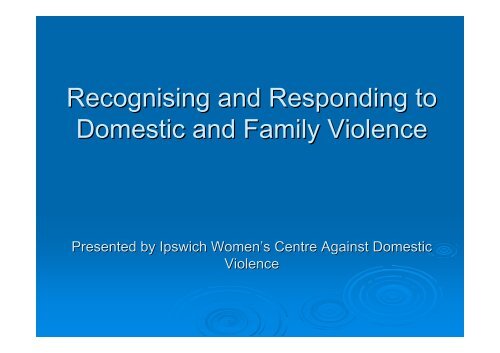

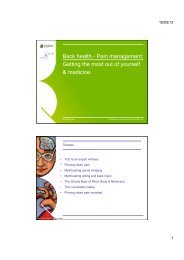
![Recycling [ PDF, 62KB ] - University of Queensland](https://img.yumpu.com/51805185/1/184x260/recycling-pdf-62kb-university-of-queensland.jpg?quality=85)
